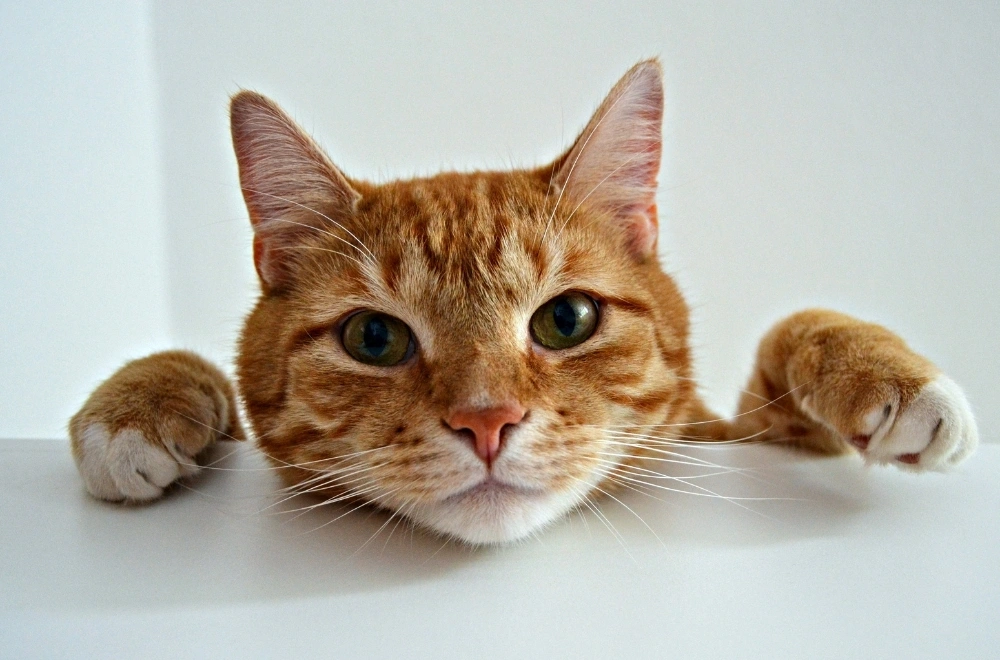Cats are fascinating creatures with complex ways of communicating. Unlike dogs, who wear their emotions on their sleeves, cats are more subtle in expressing their feelings. Understanding your cat’s body language can strengthen your bond, prevent misunderstandings, and ensure your feline friend feels safe and loved.
In this guide, we’ll break down the key aspects of feline body language, including tail movements, ear positions, vocalizations, and more. By the end, you’ll be able to “read” your cat like a pro.
1. The Tail: A Mood Barometer
A cat’s tail is one of the most expressive parts of its body. Here’s what different tail positions mean:
Upright Tail
- Meaning: A happy, confident cat’s.
- Details: When your cat greets you with a straight-up tail, often with a slight curve at the tip, it’s a sign of friendliness and contentment.
Puffed-Up Tail
- Meaning: Fear or aggression.
- Details: If the tail looks like a bottlebrush, your cat is frightened or trying to appear larger to intimidate a threat.
Tail Twitching or Lashing
- Meaning: Agitation or excitement.
- Details: A slow swish may indicate focus (like when hunting), while rapid lashing signals irritation—best to give your cat space.
Tail Tucked Under Body
- Meaning: Anxiety or submission.
- Details: A cat hiding its tail is likely feeling insecure or nervous.
2. Ear Positions: Listening to Emotions
Cat’shave highly mobile ears that reveal their emotional state.
Ears Forward
- Meaning: Curiosity or happiness.
- Details: Your cat is engaged and interested in something.
Ears Flat Against Head (Airplane Ears)
- Meaning: Fear, aggression, or annoyance.
- Details: This is a defensive posture—proceed with caution.
Ears Twitching or Rotating
- Meaning: Alertness or mild irritation.
- Details: Your cat is tuning into sounds around them or may be slightly annoyed.
3. Eyes: Windows to the Feline Soul
A cat’s eyes can tell you a lot about how they’re feeling.
Slow Blinking
- Meaning: Trust and affection.
- Details: Known as “cat kisses,” slow blinks are a sign your cat loves you. Try blinking back to bond!
Dilated Pupils
- Meaning: Excitement, fear, or playfulness.
- Details: Big pupils can mean your cat is stimulated (by play or prey) or frightened.
Staring with Narrowed Eyes
- Meaning: Aggression or challenge.
- Details: A direct, unblinking stare can be a threat—avoid staring contests with unfamiliar cat’s.
4. Whiskers and Facial Expressions
Whiskers aren’t just for sensing—they also reflect mood.
Forward-Facing Whiskers
- Meaning: Curiosity or excitement.
- Details: Your cat is investigating something interesting.
Whiskers Pulled Back
- Meaning: Fear or aggression.
- Details: Flattened whiskers indicate discomfort—time to back off.
Purring with Relaxed Face
- Meaning: Contentment (usually).
- Details: While purring often means happiness, cats also purr when in pain or stressed—check for other body language clues.
5. Body Posture: What Their Stance Reveals
A cat’s overall body position gives big hints about their emotions.
The “Halloween Cat” Pose (Arched Back, Puffed Fur)
- Meaning: Fear or aggression.
- Details: Your cat is trying to look bigger to scare off a threat.
Rolling Over (Belly Exposure)
- Meaning: Trust (but not always an invitation for belly rubs).
- Details: Some cats show their belly as a sign of comfort, but many dislike being touched there.
Crouched Low to the Ground
- Meaning: Fear or readiness to pounce.
- Details: If ears are back, your cat is scared; if tail is twitching, they’re in hunting mode.
6. Vocalizations: Meows, Purrs, and Hisses
Cats use a variety of sounds to communicate.
Short, High-Pitched Meow
- Meaning: Friendly greeting.
- Details: Your cat is saying “hello!”
Long, Drawn-Out Meow
- Meaning: Demand (food, attention, etc.).
- Details: Your cat is being insistent—check their needs.
Purring
- Meaning: Usually contentment, but sometimes pain or stress.
- Details: Observe other body signals—if relaxed, they’re happy; if tense, they may be self-soothing.
Hissing or Growling
- Meaning: Fear or aggression.
- Details: Back away—your cat feels threatened.
7. Kneading (Making Biscuits)
- Meaning: Comfort and contentment.
- Details: A leftover kitten behavior, kneading means your cat feels safe and happy.
8. Rubbing Against You (Bunting)
- Meaning: Affection and marking territory.
- Details: Your cat is claiming you as part of their family by leaving scent marks.
9. The Flehmen Response (Strange Face After Smelling)
- Meaning: Analyzing a scent.
- Details: When your cat curls its lip, it’s using the Jacobson’s organ to process smells deeply.
10. Signs of Stress or Illness
Sometimes, body language indicates health issues:
- Excessive grooming → Anxiety or skin problems.
- Hiding more than usual → Pain or stress.
- Tail flicking while lying down → Discomfort.
If your cat’s behavior changes suddenly, consult a vet.
Final Thoughts
Understanding your cat’s body language takes time and observation, but it’s worth the effort. By paying attention to their tail, ears, eyes, and vocalizations, you’ll build a deeper connection and ensure they feel understood.
Next time your cat flicks its tail or slow-blinks at you, you’ll know exactly what they’re saying!
Would you like help interpreting a specific behavior your cat displays? Let me know in the comments!
